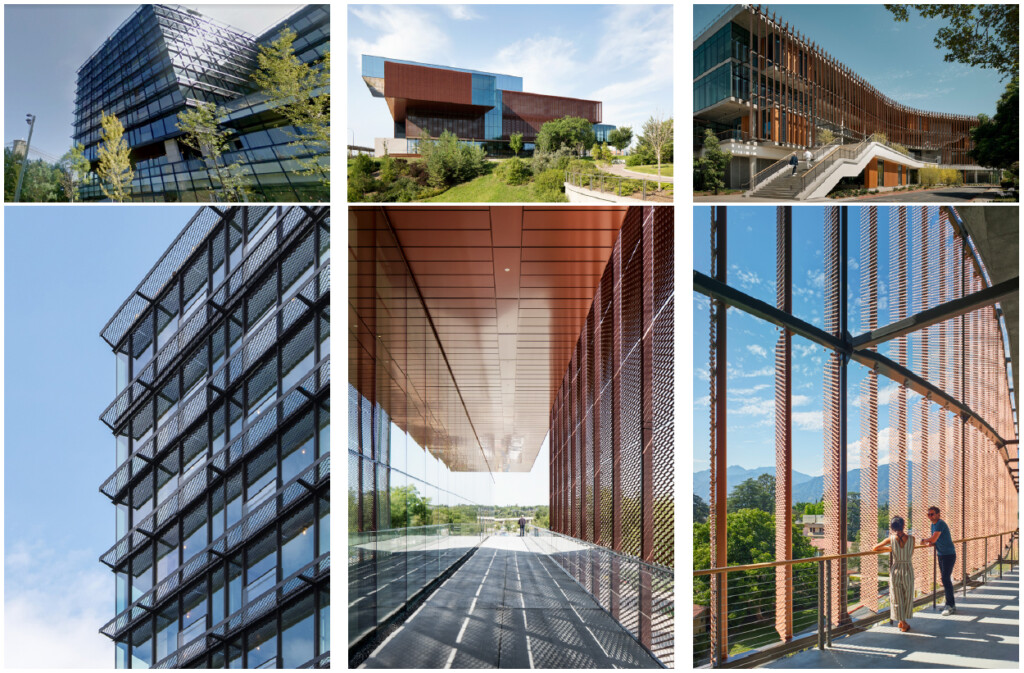QUANTIFYING EXPANDED MESH SUNSHADE HEAT GAIN REDUCTION

A long-standing practice of architects is to utilize architectural metals as a sunshade element to reduce glare, improve the quality of experience inside a building, and of course, to reduce heat gain. Typically, these designs are approached in three different ways:
- Sunshade parallel to the ground over the window
- Sunshade parallel to the window
- Sunshade Perpendicular to the window.
But how effective are these sunshade elements at reducing heat gain?
To answer this, AMICO Architectural Metal Systems retained RWDI an international climate engineering and environmental consulting firm specialized in understanding how the built and natural environments interact to perform an independent study using digital simulations to quantify heat gain change for a sunshade mounted parallel to a façade.
Study Assumptions and Set-Up
First, it is important to understand that every building will have a different set of variables that will impact heat gain results (window direction, local weather
patterns, etc.) so results will vary based on your unique design. The the goal of this study was to see if a significant change in heat gain could be observed
under a generic condition.
For this simulation, we made the following variable definitions:
- Structure: The hypothetical digital building is 32’ x 32’ with a window wall on 1 side only.
- Interior Attributes: Floor, ceiling, and walls were based on the LM-83 standard defined by the Illuminating Engineering Society of North America (IESNA)
- Location & Weather Pattern: The building site was defined as Los Angeles using a Typical Meteorological Year profile. This is an industry-standard file that provides a synthetic year of climate data where the statistics of the various parameters across each month and the year
as a whole can be considered “typical” based on long-term recordings. It defines many variables but including hours of daylight, air temperature,
typical cloud cover etc. - Surroundings: No surrounding buildings were assumed
- Orientation: The structure is oriented so that the window wall is facing due south.
- Windows Size: Continuous 6’7” x 29’6”
- Window Efficiency: The window has a solar heat gain coefficient of 0.46, a common performance.
For the sunshade, APEX01 style mesh was utilized with a horizontal diamond opening. This is one of AMICO’s most popular materials that also has the
largest visual opening (46% open); this means it would provide the most open visual experience for an occupant inside the building and block the least amount of light (and therefore heat) of any of our materials. The sunshade was defined as a matte gray fluoropolymer painted finish.
Simulation Details:
The simulation was run using ClimateStudio software using the industry standard Radiance rendering program and involved the calculation of a Bidirectional Scattering Distribution Function (BSDF) which allows the transmission and reflection characteristics of arbitrarily complex geometries
to be defined mathematically. This is a common approach for studying daylighting, solar heat gains, and building energy use since it allows for efficient
calculations of solar characteristics without the need for a detailed model of the geometry. The simulation was then arranged to measure heat gains at each
point in the room on an hourly basis over the entire course of a year.

VISUALIZATION OF SIMULATED 32” x 32” STRUCTURE WITH SOUTH FACING
WINDOW AND 1/3” COVERING WITH APEX01 MATERIAL

Simulation Results:
The results were non-ambiguous and predicted meaningful heat gain reduction using expanded mesh as a sunshade when placed within 5’ of the window.
For instance, when the window is covered 66% with APEX01 expanded mesh panels, 45% of the heat gain was mitigated. FIGURE 1 summarizes the heat gain reduction predicted under various levels of window coverage.
The relationship showed a strong linear relationship between the fraction of window area covered by the product and the percentage reduced in solar heat gains, as shown in FIGURE 2. FIGURE 3 shows visual heat maps representing the interior floor of the simulated building with the variation of the % of window coverage with APEX01 material.

*Calculated results based on digital simulation for APEX01
FIGURE 1

FIGURE 2

FIGURE 3
Interpreting the Results:
To walk through the interpretation process, we will look at a real project design from the SmithGroup using the University of Utah, SJ Quinney College of Law Building. The building is designed with a large south-facing wall of windows across 3 stories and AMICO’s APEX03 expanded mesh covering approximately 66% of the window facade.

If we were to take this building plan and construct a duplicate in Los Angeles, what can we learn about the practical savings associated with the expanded mesh sunshade?
To make these calculations we will assume the following:
- HVAC coefficient of performance (COP) = 4
- The south facing façade has 9,000 sf of windows at 0.46 solar heat gain coefficient
- California’s electricity cost is $0.25 per kWh
- California’s PG&E produces approximately 0.542 pounds of CO2 per kWh
Knowing that the building’s south face is clad 66% with APEX03, our heat gain models estimate that the mesh is eliminating 15.72 kWh per square foot of glass per year from entering the building, or 141,513 kWh in total per year. Based on California’s electrical cost, APEX03 mesh façade would save the owners $35,378/year in HVAC energy use. Assuming building owners will renovate their building facades every 20 years, the expanded mesh façade will save owners over $707,000 during the life of the sunscreen – more than paying for itself. This electrical savings would also prevent an estimated 76,700 pounds of CO2 from being emitted each year, or and over 1.5 million pounds of CO2 over the life of the screen. To put that into context, this is equivalent to preventing 111,000 pounds of coal from being burned per year or roughly 2.3 million pounds over the life of the façade.

Complete breakdown of dollar and CO2 savings from the SJ Quinney scenario given different expanded mesh styles and quantity of coverage.
FIGURE 4
Impacts on the Architect’s Design Process
Beyond all the raw numbers and calculations, how do expanded mesh sunshades impact the architect’s design process?
Improved Occupant Satisfaction:
Maximizing equitable access to daylight for all users of a facility is important. Expanded mesh can be a daylight control tool that still allows natural light deep into a space. Studies suggest that daylight has a direct impact on the well-being, productivity, and overall sense of satisfaction of users of a given space. Expanded mesh can play a significant role in the design and control of that light, even offering a tool for the designer to ensure quality through glare reduction.
Lighting Design:
Expanded mesh sunscreens can open the design possibilities of including large expansive south-facing windows that deliver consistent, ample natural light into the facility, further driving down electrical lighting loads while still balancing and controlling heat gain.
Increased Access to Windows:
For plans where municipalities or project specs are capping energy usage and driving design decisions, expanded mesh sunscreens can be a solution for deploying more windows in your design and creating a more open and pleasing environment for users to inhabit while minimizing heat gain that would otherwise drive down the window count.
